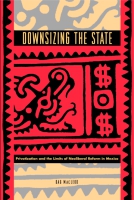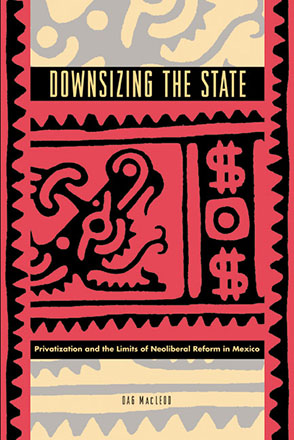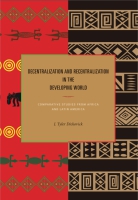Downsizing the State
Privatization and the Limits of Neoliberal Reform in Mexico
Dag MacLeod
“I very much like this book. It is the best account of Mexican privatization I have read. It is a masterful account of how the Mexican bureaucracy operates and has fantastic data to support its overall points.”
- Description
- Reviews
- Bio
- Table of Contents
- Sample Chapters
- Subjects
Drawing upon interviews with government officials, business executives, and labor leaders as well as data from government archives and corporate documents, MacLeod highlights the difficulties of linking market reforms to improved public welfare. Privatization failed to live up to its promise of raising living standards or decentralizing the economy. Indeed, privatization actually increased the concentration of wealth in Mexico while redirecting the economy toward foreign markets. These findings contribute to theoretical debates regarding state autonomy and the embeddedness of economic action.
MacLeod calls into question the autonomy of the Mexican state in its privatization program. He shows that the creation of markets where public firms once dominated has involved both the destruction of social relations and the construction of new relations and institutions to regulate the market.
“I very much like this book. It is the best account of Mexican privatization I have read. It is a masterful account of how the Mexican bureaucracy operates and has fantastic data to support its overall points.”
“This is sociology of development as it should be practiced: close to the ground and unafraid of complexities.”
“There are few books on the contemporary Mexican political economy that combine the theoretical sophistication, analytical insight, and wealth of information that this study brings to its exploration of privatization and of the implications of neoliberal reform for state-market relations. I’m not aware of any book that deals with the Mexican privatization process at this level; in this sense it is in a class by itself.”
“The book is not only about privatization in Mexico; it is about the significance of privatization in Mexico, and how to understand state-market relations more generally. The book is an impressive achievement.”
“Dag MacLeod has produced an excellent book. It is obviously well planned and well rehearsed. . . . He has managed to capture the sentiments of many ordinary Mexicans during the past decade. . . . MacLeod has carefully turned the very difficult theme of private-public sector linkages, and its contradictions, into a readable and well crafted series of case studies.”
“These two monographs on government-business relations in contemporary Mexico (Macleod’s Downsizing the State and Shadlen’s Democratization Without Representation) share the same publisher as well as the virtues of careful research and documentation, creative synthesis of theoretical strands from political science, economic sociology and new institutional economics, an explicit comparative angle and accessibility for non-area specialists. These books can be confidently recommended as texts in graduate courses on comparative politics, sociology of economic organization, business management and public administration.”
Dag MacLeod was a Fulbright fellow in Mexico in 1997 and received his PhD in sociology from the Johns Hopkins University in 2001. He currently manages the Office of Court Research at the Judicial Council of California where he conducts research on public policy and public administration.
Contents
List of Tables and Figures
Acknowledgments
Abbreviations
1. Privatization and Competing Perspectives on Economic Organization
2. Public Ownership and the Rise of State-Led Development
3. Privatization and the Demise of State-Led Development
4. The Turbulent Privatizations of Aerom eacute xico and Mexicana de Aviaci oacute n
5. Positive-Sum Games and the Sale of Telmex
6. The Transformation and Sale of the Mexican National Railroad
7. Economic Transformation and the Limits of Neoliberal Reform
Appendix
References
Index
Privatization and Competing Perspectives on Economic Organization
Determining where and in the performance of which social functions to rely on automatic, spontaneous incentive and where on artificial incentive is one of the fundamental problems facing economic systems.
—János Kornai, The Socialist System
[T]he disappearance of power when one moves from the practical world of economics to its theoretical models is based on an easily exposed liberal sleight of hand, for it is the private-public partition that makes power invisible in the economy, and this partition . . . is wholly arbitrary.
—Samuel Bowles and Herbert Gintis, Democracy and Capitalism
Privatization and the Roles of Markets and Governance in the Economy
Worldwide, more than a trillion dollars of revenue has been generated from the sales of public firms in the past two decades. The vast majority of the revenue from privatizations has come from advanced industrialized countries, predominantly Western European nations and Australia. Yet the impact of privatization may be most significant in the developing world, where public firms once accounted for a much larger share of domestic economies. In many developing countries, public firms dominated strategic sectors of national industry and played an essential role in promoting economic development, maintaining political stability and defending national sovereignty (Megginson and Netter 2001; Privatisation International 1998, 22, 24; Yergin and Stanislaw 1998).
Indeed, the importance of public firms in the developing world went far beyond their economic role. Beginning with the world depression of the 1930s and continuing through the post–World War II period, many developing countries built vast empires of state-owned firms, creating and expropriating companies in mining, oil, steel, electricity, rail, telecommunications, civil aviation, and almost every other sector of their economies. Public firms were an integral part of the import-substituting industrialization model that was adopted to varying degrees throughout the developing world. As such, these firms supported specific political coalitions, providing high-wage jobs to workers, low-cost inputs to capitalists, political patronage to state bureaucrats, and subsidized goods and services to citizens. Public firms also defended many developing countries from economic domination by the multinational firms of industrialized countries and became potent symbols of national pride and developmental aspirations, occupying the commanding heights of both the economy and the polity (see Carrillo Castro and García Ramírez 1983, 148; Ramamurti 1996; Teichman 1995; Waterbury 1993; World Bank 1995a).
In this book, I examine one of the more remarkable cases of privatization in the developing world: Mexico’s privatization program between 1983 and 2000. After more than fifty years of growing state intervention in the economy, Mexico abruptly abandoned public ownership in 1983 and reduced the number of state-owned firms from more than eleven hundred to barely two hundred by the year 2000. Mexico began privatizations earlier than most other developing countries and sustained the process over a longer period of time. Out of approximately $96 billion raised from privatization in the entire developing world between 1988 and 1993, more than one-quarter, $24.3 billion, came from Mexico. Between 1994 and 2000, Mexico continued to lead the developing world in privatization, opening basic infrastructure such as natural gas, the generation of electricity, satellite communications, ports, airports, and railroads to private investment (Rogozinski 1997, appendix 1; Spiller and Sales 1999; World Bank 1995a, 27).
The sweeping reforms introduced in Mexico since 1983 have been attributed to the “relative autonomy and insulation of the state vis-à-vis political pressures,” “insulated change teams,” and an “autonomous but embedded bureaucracy” (Petrazzini 1995, 6; Waterbury 1993, 3; Centeno 1994, 47). In this book, I argue that the designation of the Mexican state as “autonomous” distorts and oversimplifies the actual role of the state in carrying out privatizations. The application of the label autonomous to the Mexican state stems, in part, from a conceptual shift that has extended the meaning of autonomy from implying a concern with the independence of the state from elites to indicating state independence from any social pressure. Thus, the state’s ability to overcome the interests of workers, peasants, and other popular-sector groups is sometimes said to constitute a form of autonomy.
Yet even where the pressure of elites upon the state is acknowledged, research on Mexico has still concluded that the Mexican state was autonomous by virtue of its coherent, effective bureaucracy. Here, too, I will present evidence that shows a more complex relationship between public and private actors. While the centralization of power in the Ministry of the Treasury was crucial to Mexico’s privatization program, state actors also relied heavily upon the expertise and guidance of private consulting firms, international agencies and “agent banks.” Rather than strengthening the bureaucratic capacity of the state, state managers actually subcontracted essential tasks to these other institutions, in effect privatizing part of the privatization process itself.
The question of state autonomy, however, is only one aspect of a larger question regarding the interrelationship between markets and governance in capitalist economies. In recent years, contributors to a growing body of literature in economics, political science, and sociology have emphasized that successful markets depend on social and political institutions that operate on principles quite different from those of the market. Sociologists, in particular, have documented the myriad ways in which markets are embedded in social relations and nonmarket institutions that contradict the fundamental premises of neoclassical economics. These intellectual developments, however, seem to fly in the face of economic reforms around the world that are designed to unleash market forces: not only the privatization of public firms, but movements toward economic integration and deregulation that attempt to limit the extent to which nonmarket institutions determine economic allocations.
In this book I seek to bridge the gap between research in economic sociology that has demonstrated the poverty of neoclassical economic theory and the wave of economic restructuring that appears to conform to many of the principles underlying neoclassical economics. I do so first by building a theoretical model out of parts taken from economic sociology, classical political economy, and institutional economics. Rather than assume that nonmarket institutions invariably restrict the ability of actors to engage in market exchange, the model allows for an examination of the ways in which nonmarket institutions both limit and facilitate the operation of markets along the lines posited in neoclassical economics.
The argument that I make can be summarized as follows. The neoclassical conception of markets as atomized and asocial highlights an important feature of social organization that economic sociology needs to acknowledge and incorporate into its research agenda. Capitalist markets are defined in part by a functional separation of actors from one another that permits them to operate in a manner that resembles neoclassical models. I borrow from institutional economic theory to show how legal and political structures—in particular property rights and hard budget constraints—create barriers to cooperation and collaboration among actors. These barriers enable and encourage exchange based on competition and utilitarian calculations of price and profitability not unlike that which neoclassical theory posits as the natural state of affairs. At the same time, I argue that there are limits to which an economy can function upon these principles, as illustrated by the concepts of market failure and transaction costs. I argue that there is an inherent tension between economic organization based on market exchange and the institutions that stabilize market exchange by correcting market failure or overcoming transaction costs. At certain historical junctures these tensions can no longer be reconciled, and new regulatory institutions and new markets are created.
Arguments regarding the structure of the economy beg the question of who the agents are that build markets and lead back to the issue of state autonomy. Here I argue that economic reforms in Mexico were the outcome of social struggles for and against the commodification of specific areas of the economy. Actors who stood to benefit from the extension of market principles to the production of certain goods and services pushed the state to separate, or “disembed,” these areas of economic activity from the public sphere and the social obligations attached to nonmarket institutions. Actors whose interests were threatened by the creation of markets worked against this process (Polanyi 1957, 132). I argue that the “autonomy” of the state, understood as its capacity to implement policies, cannot be disentangled from the content of these policies and the coalitions and alliances that support and oppose them.
These theoretical formulations, however, are useful only insofar as they serve to guide empirical research. Therefore, I use the theory developed in this introductory chapter as a framework of analysis for examining the nuts and bolts of how markets were created in Mexico’s privatization program. In Chapters 2 through 6, I draw on seventy-eight key-informant interviews conducted with fifty-eight unique sources to provide a detailed picture of the privatization process in Mexico between 1982 and 2000. These interviews are supplemented with data from government archives, legislation, press reports, corporate documents, trade publications, and secondary sources to foster an understanding of the reach and limits of Mexico’s economic reform program (see the Appendix for details on the methodology).
In the remainder of this chapter, I outline key concepts that will be used for studying the relationship between markets and governance in the economy. I show that the governance functions of the state actually belong to a broader category of nonmarket exchanges that are performed not only by the state but also by other social institutions within the economy, the most important of these being private firms. I argue that all market-based economic activity depends in some measure on nonmarket exchanges but that markets in a capitalist economy function in a manner that makes exchange appear independent of the social institutions upon which it depends. This model, then, requires that we examine how the chain of market and nonmarket exchanges is cobbled together so that private actors can appropriate resources from social institutions while, simultaneously, shielding these resources from public oversight or confiscation.
Chapter 2 provides a broad overview of the rise of state ownership in Mexico between 1917 and 1982. In this chapter I look at the legal and political foundations of public ownership, the number and types of firms incorporated into the state sector, and the role that public firms played in managing the state’s relationship to labor, domestic capitalists, and the international economy. In Chapter 3, I examine the demise of the state-led development model from 1982 through 2000, looking at where and how the state privatized firms and introduced market reforms during the final three presidencies of the Revolutionary Institutional Party (PRI).
Chapters 4, 5, and 6 sharpen the focus of the study; here I examine the growth and decline of state intervention in specific industries within the transportation and communications sectors. These sectors are especially interesting for both theoretical and practical reasons. Theoretically, they are areas of the economy in which there is broad agreement about the legitimacy of state intervention. These sectors tend to produce positive externalities, with clear implications for national development, making the introduction of market reforms in transportation and communications more difficult than in other sectors of the economy. The practical justification for focusing on transportation and communications is equally compelling. Privatization within these sectors marked a major turning point in the process of selling state firms in 1988, included the single largest privatization in Mexico in 1990, and became the focus of intensified reform efforts between 1995 and 2000.
In Chapter 4, I examine the privatization of the Mexican airlines Aeroméxico and Mexicana de Aviación. Initiated at the end of the de la Madrid presidency, the sale of Aeroméxico, following its bankruptcy, was one of the first sales of a large firm that involved two of the three elements that would become key components of later privatizations: organizational restructuring of the firm and confrontation with labor unions. The subsequent privatization of Mexicana de Aviación added the third element that characterized this later phase of privatization: investment by foreign firms. By the early 1990s, however, intensified competition undermined profitability, and the two carriers attempted to blunt the effects of debilitating price wars by increasing the coordination of their activities. By 1995, both firms had gone bankrupt and were rescued by a government bailout.
In Chapter 5, I discuss the single largest privatization completed in Mexico: that of the telecommunications monopoly Telmex. The sale of Telmex was highly symbolic and allowed the Salinas administration to give economic restructuring a human face. The privatization of Telmex required even greater foreign investment than had Mexicana de Aviación and demanded a more complex restructuring of the firm. The privatization of Telmex also produced a more ambiguous outcome for the workforce, securing important guarantees for workers while also tying their interests more closely to that of the firm. While Telmex has remained profitable, its success appears to be the result of numerous restrictions on the influence of competition and price in the market.
The privatization of the Mexican National Railroad (FNM) is the subject of Chapter 6. The sale of FNM involved a complete transformation of the Mexican rail system. Throughout the twentieth century, the Mexican state consolidated the vast network of private rail companies into the operating structure of FNM. Following the debt crisis of the 1980s, this process was accelerated and the last remnants of private ownership were eliminated. Once consolidated, these assets could be evaluated and separated into individual, marketable rail companies. While the sale of Telmex provided trade-offs to workers in exchange for restructuring, the privatization of FNM depended on the iron grip of the official railroad labor union and the political power of the PRI to reward the leadership of the union.
Chapter 7 revisits the question of how states and markets may be separated from each other even while they remain interdependent. Drawing on examples provided in the case studies, in the concluding chapter I look first at the structural reorganization of economy and society in Mexico, then review the agents who supported and opposed the economic transformation and, finally, touch briefly on the political consequences of economic change. While the election of Vicente Fox Quesada in 2000 has reinforced the notion that economic and political liberalization go hand in hand, I argue that the election of Fox can be attributed more to the failure of economic reforms than to their success. While market reforms steadily eroded the living standards of large numbers of Mexicans, political reform became a key inducement used by the ruling party to reinforce its legitimacy. Although these reforms ultimately proved costly to the PRI, political reforms were implemented only after the scale and scope of state intervention in the economy had been significantly reduced, limiting the reach of a democratically elected government.
I encourage readers who are more interested in the empirical findings than in the theoretical implications to skip directly to Chapter 2. Although the organization of Chapters 2 through 6 is guided by the theoretical framework developed in the following pages, each of the empirical chapters should stand on its own.
Mailing List
Subscribe to our mailing list and be notified about new titles, journals and catalogs.







